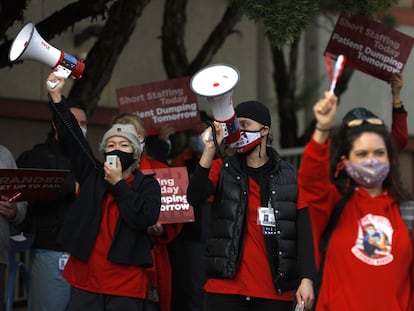The Native American tribe that has nothing to celebrate at Thanksgiving
A full 400 years after the meal with English colonists that gave rise to a US federal holiday, the Wampanoag, who survive on the coast of Massachusetts, are striving to tell the real story of that encounter and its devastating consequences

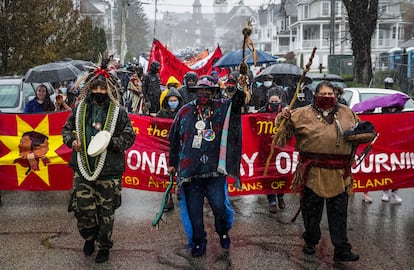
Plymouth, on the coast of Massachusetts, is a distinguished town that lives off the business of memory. And this week is high season. It was 401 years ago that the Mayflower landed near this spot with a boatload of pilgrims fleeing religious persecution and seeking a new life in the New World. A modest rock protected by a colonnade built in a Neoclassical style marks the spot where they allegedly set foot on the shore. It was then that the settlers came into contact with a handful of native people, forming the genesis for Thanksgiving, a holiday that brings millions of Americans around the dinner table on the fourth Thursday of November, even in these polarized times.
But for the Wampanoag people, who have been living in the Cape Cod area for the last 12,000 years, Thursday is not a day for celebration. Hundreds of them were planning to march down the streets of downtown Plymouth to observe their National Day Of Mourning because “Thanksgiving Day is a reminder of the genocide of millions of Native people, the theft of Native lands and the erasure of Native cultures,” says the organizing association, United American Indians of New England, on its website.
At age 29, Brian Moskwetah Weeden is the youngest chairman ever elected to lead the Wampanoag Tribal Council of Mashpee, located 40 kilometers south of Plymouth and home to the largest group of descendants of the first Wampanoag to come into contact with the Pilgrims. Sitting in his office, Moskwetah explains that these approximately 2,900 descendants have “nothing to give thanks for” at Thanksgiving. “What should we be grateful for? That 400 years ago we had our own land and lived our own way? That we were forced to embrace Christianity? For us, that marks the origin of a historic and enduring trauma,” he says, noting that Native Americans have the highest rates of alcohol and drug addiction, as well as suicide, in the entire United States.

According to Moskwetah, the Wampanoag currently have around 320 acres of land to their name, the equivalent of nearly 130,000 hectares and around 0.5% of the territory that his people occupied in the 17th century (they did not formerly own the land, as the concept of private property did not exist before the arrival of the English settlers). That chunk of the promised land extended from Rhode Island in the north to Nantucket Island in the south.
Getting over that trauma has been a lifetime endeavor for Linda Coombs, a historian of the Aquinnah Wampanoag, whose home is located in what is today known as Martha’s Vineyard, a famous summer resort for the rich and famous. Coombs, who is considered an institution in the area, has joined forces with other activists to restore the memory of what really led to the First Thanksgiving and, above all, of what followed. Coombs and her colleagues are fighting to debunk a myth that was created in the 19th century and taught at schools, then extended by Hollywood to every corner of the planet. The historian first heard the official story in class, when she was just a child, and on Tuesday she recalled the way it went: “The Natives and the English came together, hit it off, they were happy and they ate turkey. After that the Natives, who do not even deserve a name, faded into the background. End of story.”
Around 100 pilgrims had arrived the previous winter on the Mayflower. Only half of them survived the tough new conditions, partly thanks to the fact that they learned how to grow corn from the indigenous population. Contact with the Europeans had been taking place for over a century, but they were the first ones who came with the intention of settling down, explains Coombs. In 1616, one of those earlier contacts had triggered an epidemic that killed between 75 and 90% of the Wampanoag, whose numbers at the time are estimated to have been between 30,000 and 100,000. Those losses pushed one of the tribe leaders, Ousamequin, to ally himself with the pilgrims and their firearms against the threat of the Narragansett tribe. So it was strategy, not hospitality or the wish to make new friends, that brought both groups together.
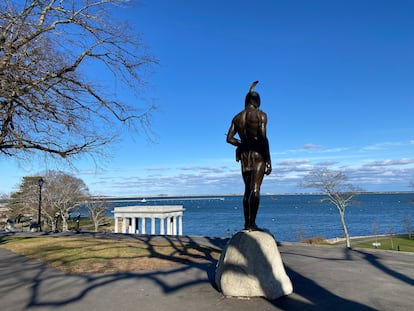
On November 1621, the English celebrated the success of their first harvest in the New World and the abundance of food. The celebrations included firing shots in the air, a sound that brought Chief Ousamequin and 90 of his men galloping over, ready for battle. When they realized it was a false alarm, they joined the celebration, so it’s also not true that they had been invited to the table.
They probably ate turkey and other wild birds, as well as fish, seafood, venison, corn and peas, but there are many food items on modern Thanksgiving menus that were not there in the early celebrations. “In the 17th century they did not have butter, flour, sugar or potatoes,” says David J. Silverman, a history professor at George Washington University and author of This Land Is Their Land: The Wampanoag Indians, Plymouth Colony, and the Troubled History of Thanksgiving.
Beyond food-related inaccuracies, Silverman is concerned about the way history has concealed what came after, which is essentially “the same as any other colonization process: war, dispossession, slavery and marginalization.” According to Silverman, historians are caught up in a heated debate over whether it could be described as genocide, but “if you compare it with the United Nations’ definition, the way this country treated Native Americans neatly fits into that description.”
Perhaps because of that uncomfortable legacy, the myth of extinction has flourished in the American collective consciousness. “For too many years, schools taught that after that, the natives simply disappeared from the scene, just when they stopped serving the interests of the story of the foundational myth. When that’s not true,” says Donna D. Curtin, director of Pilgrim Hall Museum in downtown Plymouth.
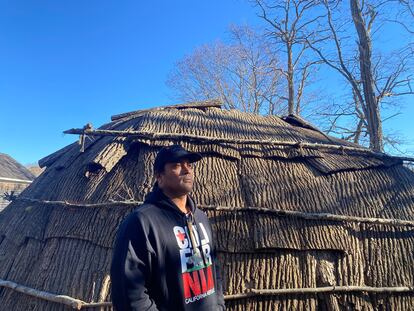
There are a number of places in the area like the one that Curtin runs, catering to historical tourists. Perhaps the most visited is Plimoth Patuxet, an open-air “living museum” founded in 1947 by Henry Hornblower III, a financier with a love of the past. Until 2020, it was called Plimoth Plantation, but given the Black Lives Matter protests the “plantation” reference was removed from the name, given its racist overtones. It has a room that is dedicated to Thanksgiving, in which the forging of the false legend is explained. There is only one primary source that explains what happened that day, a single paragraph in a letter from a passenger on the Mayflower to a friend. When this paragraph was included in a book in the 19th century, the author added a footnote (“the most influential footnote of all time,” according to Silverman) with the idea that this was the “first Thanksgiving,” despite the fact, the historian adds, “that it wasn’t special for the English nor for the Wampanoag.” During the War of Secession, President Abraham Lincoln made use of that legend to try to unite a country that was split in two. And in 1941, the holiday became federal.
Historian and actress Malka Benjamin works in the area of Plimoth Patuxet that recreates life in an English village four centuries ago. Dressed as a pilgrim, she explains that the guides in the Wampanoag settlement are not dressed up to give the impression that “this is not a place of the past, but is still very much alive.” Despite gestures such as this one, the narrative of the museum is very uncomfortable for a lot of Native Americans, such as Steven Peters. “They are too late, and in many ways that place is a lost opportunity,” Peters complains from the home in Mashpee that he shares with his family. He was also told in class “the history of the Indians who disappear just like that,” without regard for the fact that living proof of just the opposite was listening to the class.
“At the school of my children, who are nine and three, I believe that they avoid the subject,” he explains. “In schools that do have Native American students they have doubts about how to teach Thanksgiving and prefer to not say anything rather than embracing a mistaken narrative. In this country, there are many who believe that our story starts with the arrival of the English, and that everything that came before is prehistoric. It’s like saying that African American history starts with slavery: it’s incredibly offensive.”
Together with his wife and his mother, Paula Peters, another respected leader of the community, Steven runs an agency called SmokeSygnals, which sets up exhibitions about the history of his people and also offers advice for education programs and museums about how to deal with the issue from a non-problematic perspective. Among his clients is the Mashpee Wampanoag Indian Museum, a modest institution that’s located by the side of a freeway, and that receives some 800 visitors a year.
Its director, David Weeden, explains that the museum was founded in the 1970s, when the area saw an unprecedented demographic explosion. Mashpee was filled with outsiders, in many cases vacationers, and the tribe was left in the minority – today, in fact, they represent 20% of the population.
“In the 1980s and 1990s, it was the fastest-growing municipality in the United States,” Weeden explains. “In November, which is Native American Heritage Month in the US, and around Thanksgiving, we get more attention, but this museum is here to remember our history during the whole year. And to also remember that we are still fighting for the same things four centuries later: our land, our language and our right to exist. And that we are still here. We were not savages, despite what many think, we were living in harmony among ourselves and with nature before the Europeans arrived. I wish that they had been willing to learn something from my people, instead of imposing on us the rules of a society that they were supposedly fleeing from. Perhaps the problem of climate change would not be as serious now as it is. That was the beginning of our end. That’s why we don’t see the point of celebrating anything that we don’t celebrate in the number of harvest festivals that we have over the entire year, apart from the National Day of Mourning.”
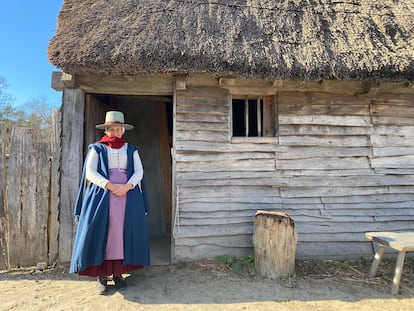
That protest was called for the first time in 1970, when the governor of Massachusetts invited the Wampanoag leader Frank James to make a speech for the 350th anniversary of the arrival of the Mayflower. When the governor read the text, he demanded changes be made. James refused, and the idea of the protest came about. They will stop holding it when they achieve equal rights. The text included the following sentence: “We, the Wampanoag, welcomed you, the white man, with open arms, little knowing that it was the beginning of the end; that before 50 years were to pass, the Wampanoag would no longer be a free people.”
The first efforts to legally reclaim their land also date from the 1970s. Today they count on 320 acres. Two Wampanoag families, the Mashpee and the Aquinnah, enjoy federal recognition, a prior requisite for reservation status. They managed this at the end of the second term of President George W. Bush. President Barack Obama ratified that right, which was later challenged in the courts by the administration of President Donald Trump. In February of this year, with Joe Biden in the White House, the federal government decided to end its legal challenge. Since the appointment of Deb Haaland – a member of the federally recognized Laguna Pueblo Native American tribe – as secretary of the interior, the Wampanoag are seeing more favorable winds blowing in Washington.
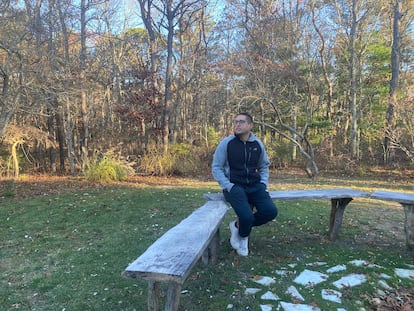
Despite this, all of the Native Americans consulted for this article responded affirmatively when asked if they suffer racism in their daily lives. Moskwetah explains that Massachusetts has yet to replace its “coat of arms, which bears an offensive representation of an Indian,” and also points to the fact that people “dress up as Pocahontas” at Halloween, “without being aware of what that gesture implies.” There are also sports teams, such as the Kansas City Chiefs, that “perpetuate the age-old negative stereotypes,” he adds. The governor of the state, Charlie Baker of the Republican Party, is still yet to embrace the change in the denomination of Columbus Day for Indigenous Peoples Day (Boston made the switch in October).
“Even when they want to lend a hand and tell our story, they do it in a way that is essentially racist, because they don’t include us,” explains Coombs, pointing out the place where it is thought that the Thanksgiving dinner was celebrated 400 years ago. Today it is a crossroads with traffic lights, a sandwich store and a post office. There is also a plaque that commemorates another unfortunate incident for the Wampanoag: the defeat of Metacomet, son of Osamequin, in the bloody conflict known as King Philip’s War (1675-1678), an uprising against the colonists that was cruelly put down. The rebel leader was beheaded, and his head was left on show for all to see for 25 years.
It’s clear that back then, the business of remembrance was not such a slippery topic as it is today, but it was certainly much more cruel.
Tu suscripción se está usando en otro dispositivo
¿Quieres añadir otro usuario a tu suscripción?
Si continúas leyendo en este dispositivo, no se podrá leer en el otro.
FlechaTu suscripción se está usando en otro dispositivo y solo puedes acceder a EL PAÍS desde un dispositivo a la vez.
Si quieres compartir tu cuenta, cambia tu suscripción a la modalidad Premium, así podrás añadir otro usuario. Cada uno accederá con su propia cuenta de email, lo que os permitirá personalizar vuestra experiencia en EL PAÍS.
¿Tienes una suscripción de empresa? Accede aquí para contratar más cuentas.
En el caso de no saber quién está usando tu cuenta, te recomendamos cambiar tu contraseña aquí.
Si decides continuar compartiendo tu cuenta, este mensaje se mostrará en tu dispositivo y en el de la otra persona que está usando tu cuenta de forma indefinida, afectando a tu experiencia de lectura. Puedes consultar aquí los términos y condiciones de la suscripción digital.
More information
Archived In
Últimas noticias
Most viewed
- Reinhard Genzel, Nobel laureate in physics: ‘One-minute videos will never give you the truth’
- Oona Chaplin: ‘I told James Cameron that I was living in a treehouse and starting a permaculture project with a friend’
- Pablo Escobar’s hippos: A serious environmental problem, 40 years on
- Charles Dubouloz, mountaineering star, retires at 36 with a farewell tour inspired by Walter Bonatti
- Why we lost the habit of sleeping in two segments and how that changed our sense of time
